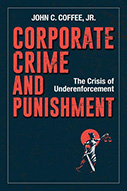Corporate Crime And Punishment: The Crisis Of Underenforcement

Author: John C. Coffee, Jr.
Publisher: Berrett-Koehler Publishers, 2020. 216 pages.
Reviewer: Miriam H. Baer ǀ January 2022
Why does our society continue to underenforce corporate crime? This is the question that fuels Professor John Coffee’s newest book, Corporate Crime and Punishment: The Crisis of Underenforcement, and he answers it primarily with what he calls a “logistical mismatch” hypothesis (pp. 13–14). The problem isn’t just prosecutorial risk aversion, as the DOJ’s critics have argued, or criminal law’s inability to address excessive risk-taking, as others have opined. Instead, the real problem is one of resources: federal prosecutors and enforcement attorneys are just too overburdened to properly investigate corporate scandals and complex schemes, particularly ones that spill into international jurisdictions (p. 141). Speaking of one of DuPont’s environmental disasters, Coffee bluntly observes, “only an extended investigation could uncover the true facts and that is generally beyond the capacity of most prosecutorial offices” (p. 5). Accordingly, the federal government is simply no match for “the nearly limitless capacity of the large corporation to resist and delay” (p. 13).
So begins Coffee’s romp through the 2008 financial crisis, its confounding aftermath, and his extended survey of all that ails federal corporate law enforcement. The book addresses weaknesses in civil enforcement as well, and it touches on everything from Deferred Prosecution Agreements to SEC settlements, as well as the effects of fines and whistleblowing programs. Despite its breadth and subject matter, Coffee insists that his is not an “academic” book (p. ix), which is true insofar as the opening chapters simplify for the nontechnical reader the institutions, procedures, and enforcement challenges endemic to corporate crime. Nevertheless, Coffee clearly constructs an academic argument (well, many), peppered with long asides that draw on law and economics, public choice, and deterrence theory.
For those who already study and write about this subject, much of the book covers familiar ground: Coffee begins by describing the government’s ill-fated prosecution of Arthur Andersen (back then, one of the top accounting firms), the 2008 financial crisis and the eventual bankruptcy of Lehman Brothers, and the maddening failure to successfully punish any of the top executives who pitched the country into a crisis followed by a recession (Chapter 2). From there, Coffee explores post-crisis enforcement developments (Chapter 3), as well as the government’s overreliance on corporate actors to self-police and provide information (Chapters 4 & 5). For readers new to this area, these early chapters make for an enjoyable and often insightful review.
One of Coffee’s key observations—made numerous times by others, several of whom he cites and mentions favorably in the text—is that the government gets too little out of its relationship with corporate offenders (p. 74). The DOJ’s corporate charging policies are supposed to trade lenient treatment of corporate offenders for self-policing, improved compliance measures, and a freer flow of information to government regulators and prosecutors. If the exchange worked as intended, corporate crime would presumably plummet to acceptable limits.
Instead of reaching this nirvana, Coffee laments, recidivist corporate offenders evade criminal punishment; shake off modest, externalizable fines; provide insufficient assistance in identifying guilty corporate executives; and ultimately remain under-deterred. Or, as Coffee memorably puts it, “[t]oo often, only the corporation (and not the state) gets the benefit of the bargain” (p. 58). Thus, it shouldn’t surprise us that the general public has come to distrust the public enforcement bureaucracy even more than it distrusts corporate America.
None of this is new, but Coffee’s discussion entertains as it diagnoses. The book’s most memorable vignette is Coffee’s cutting critique of the Lehman Brothers case, which resulted in no prosecutions of the company’s officers (Chapter 2). The government’s failure to punish any of Lehman’s officers (its “abdication,” according to Coffee) informs much of the book’s diagnosis and prescriptions (p. 23).
According to Coffee, the Lehman episode vividly demonstrates the government’s David versus Goliath story, albeit with a really dispiriting ending in which Goliath pounds an already weakened David into the ground. Whereas the United States Attorney’s Office for the Southern District of New York (SDNY) reportedly assigned a single prosecutor to investigate Lehman’s demise, the bankruptcy examiner who later examined the same materials drew on “the full resources of his law firm,” including some 130 attorneys (pp. 26–27). And whereas the SDNY investigation ultimately cratered with nothing to show for it, the bankruptcy examiner eventually excavated several accounting gimmicks that could have served as the basis of an SEC fraud case (pp. 24–27). The Lehman parable thus yields two conclusions: (1) complex investigations require a deep well of resources and (2) the government cannot possibly attract and deploy such resources.
Before we go any farther, it is worth noting that Coffee’s narrative rests upon an incomplete and unofficial record. Even if we accept the lapses Coffee describes, we still don’t know the full scope of the prosecutors’ investigation. This ‘black box’ problem isn’t unique to the Lehman case. The government’s utilization of its investigative resources is purposely designed to be opaque, in part to prevent would-be wrongdoers from reverse engineering government investigations. Accordingly, prosecutors rarely provide much more than platitudes to explain their declination decisions, much less describe their investigations in painstaking detail. Coffee’s footnoted account therefore relies in large measure on the reporting of Jesse Eisinger, a journalist who was highly critical of the government and the financial crisis’ aftermath. Indeed, a good chunk of Coffee’s early discussion is a polite refutation of Eisinger’s highly popular The Chickenshit Club: Why the Justice Department Fails to Prosecute Executives (2017). Eisinger derides prosecutors for having become too risk averse; Coffee contends there is just as much evidence that they lack the necessary resources to get the job done. Absent access to the prosecutors themselves or their specific files, it’s difficult to know which explanation is most accurate.
Lehman is an interesting case because the entity was essentially defunct by the time federal prosecutors began examining its records. In most cases, the corporate offender will still be a going concern when the prosecution contemplates its future. To prevent legitimate businesses from faltering and to take advantage of the corporation’s deep pockets, prosecutors have eschewed scorched earth tactics and have instead pressured corporations to shoulder enforcement costs by having outside defense firms investigate the alleged wrongdoing and share their results with government agencies (pp. 82–83). This development, according to Coffee, has “become the largest new source of business” for American law firms (p. 45).
Coffee strongly dislikes this version of government outsourcing. He predicts that the corporate defense firm acting on the corporation’s behalf is unlikely to unearth any wrongdoing pertaining to the company’s highest-level executives or board members, who select the law firm and pay its bills (p. 82). This conflict of interest, says Coffee, renders the white-collar defense bar a suboptimal agent for government prosecutors expecting to benefit from the fruits of corporate self-policing (pp. 45–46). To be clear, there are additional constitutional implications that arise out of the government’s pressure on corporations to undertake so-called ‘private’ investigations, which Coffee broaches and have attracted attention from other scholars in recent years (pp. 84–87) (See, e.g., Baer, 2021 (examining implications of a shifting ‘state action’ doctrine for the fruits of private investigations); Arlen & Buell, 2020 (contrasting United States’ relatively permissive investigative rules with those of foreign governments and discussing their impact on corporate settlement procedures)).
So, what should the government do instead? For civil cases, Coffee urges the SEC to hire plaintiff-side securities fraud attorneys to investigate wrongdoing. The fruits of their labors can then be used by government prosecutors to pursue and settle enforcement proceedings (pp. 83–84, 100–104). For criminal investigations (particularly ones that already presuppose a Deferred Prosecution Agreement with the target company), Coffee envisions a slightly different scheme wherein the prosecutor maintains a list of “preferred class counsel” (presumably, the same types of attorneys he would rely on in civil cases) who would be available to conduct investigations when needed (p. 87). The corporate offender would still pay the bills (and the government agency apparently would still retain its discretion to direct the prosecution (p. 103), but the “preferred attorney” would be more responsive to the government’s needs insofar as it wished to remain on the government’s “small list of firms they had cultivated and worked with” (p. 87).
Both plans contemplate a shift in reliance; instead of using corporate defense firms to investigate wrongdoing, the government will instead turn to successful attorneys culled from the plaintiffs’ bar. According to Coffee, the latter group will do a better job their members are: (1) unbeholden to corporate boards and managers; (2) more skilled, experienced, and aggressive than government attorneys; and (3) properly motivated by their contingency fee structure, which permits them to take on risk but also encourages them to persist until they get paid (pp. 100–03).
Meanwhile, for criminal investigations, Coffee further recommends that the DOJ expand the SEC’s whistleblowing program (notwithstanding the remarkably few cases the SEC yields from the thousands of tips it receives on an annual basis) and be more entrepreneurial in its quest for information (p. 143). Thus, Coffee advises:
[R]ather than just rely on the submissions of random whistle-blowers, the government needs to indicate more clearly the information it most wants. For example, the agency could indicate to the employees of one or more corporations that it wanted information from persons with direct knowledge about payments or monetary transfers to specific companies or persons within a given time period and that it was authorized to pay substantial amounts for such information if it proved useful. When the bounties are high, whistleblowers will predictably appear and respond (p. 143).
Coffee proposes many other reforms, but these convey the book’s overriding theme: it’s time for the government to toughen up, be more aggressive, become more entrepreneurial, and more ruthlessly exploit the levers of government power to secure more information and greater deterrence.
Coffee often portrays his proposals as common-sense reforms that only a tunnel-visioned or turf-protecting bureaucrat would resist. To some degree, his impatience is warranted. Enforcement institutions are plenty bureaucratic and, indeed, sometimes sclerotic. And it seems highly unlikely to me that any self-respecting enforcement agency would openly embrace Coffee’s contention that it is intractably outgunned. Nevertheless, I found different reasons for skepticism as I plowed through the final third of the book.
Let’s start with his government-directed whistleblower program, in which prosecutors are encouraged to dangle lots of money before employees in exchange for specific categories of information, or as Coffee puts it, “the information [the government] most wants.” Prosecutors who rely on Coffee’s advice will confront two problems. First, if the putative whistleblowers are also guilty of wrongdoing (which is certainly possible), there are both moral and tactical reasons to decline to pay them any financial bounty, let alone “substantial amounts” of money (p. 143). Second, even if these witnesses are themselves untainted by wrongdoing, the offer and acceptance of massive sums of money will impair their credibility before a jury, particularly if the government requests specific categories of information from a putative whistleblowing pool. These seem to be rather weighty predicaments that prosecutors and their supervisors would have to grapple with; it would have been helpful for Coffee to preview his answers to these pressing questions.
Coffee’s proposal to hire plaintiffs’ attorneys to spearhead investigations provokes a different series of concerns. First off, he is on solid ground that government agencies periodically seek the assistance of the private bar (pp. 104–05). But Coffee clearly wishes to expand this program to nearly all major investigations of corporate malfeasance that are too big or ‘too risky’ for the government agency to handle. Here, my own skepticism arises not out of implementation-related concerns (although I can imagine many, including conflicts of interest issues), but rather from a more foundational question about the government’s role in ‘public’ enforcement. Why it is we continue to think it is a good idea to outsource what is clearly a public obligation to private attorneys? Is the aim simply to make the government a more effective player, more adept at exploiting a competition for leniency among corporations and their managers? If so, that belies a rather impoverished conception of public enforcement.
Criminal law scholars often speak of the expressive and restorative purposes of punishment, of the ways in which a criminal case (in its best sense) can play an educative, condemnatory, and reconstructive role within the community (See, e.g., Kleinfeld, 2016; Hart, 1958). To many, this suggests a uniquely government-directed function, one which teaches and reaffirms as much as it induces and deters. Perhaps this is the moment that Coffee’s admonition that his is not an “academic” book rings most true: as much as it employs deterrence and other academic interests as points of departure, it does not concern itself too deeply with either criminal law’s political foundations or the philosophical justifications for punishment (See generally Ouziel, 2020 (analyzing the fraught relationship between elected officials and the unelected bureaucrats who manage the criminal justice system in times of political transition); Cahill, 2007 (explaining retributive theory and its relationship to criminal enforcement dilemmas)). Given Coffee’s practical concerns, one can understand the decision to sidestep this thicket. These literatures, however, offer helpful clues for why some readers will be justifiably reluctant to embrace Coffee’s proposals.
The expressive theory of criminal punishment begins with the legislature’s decision to criminalize a given activity, but it does not end there. The manner in which we police and investigate criminal activity conveys potent signals as well. Shifting corporate investigations from one set of private attorneys to another group of private attorneys highlights how deeply mired we have become in second-best proposals for redressing the government’s enforcement gaps. We say we want the government to police the private sector, but then we strangle it of resources and force it to outsource much of its work. You can dress this up as some form of ‘new governance’ (as scholars once did in the past) or insist that you are solving the government’s manpower problem (as Coffee does here), but sooner or later the system’s flaws become painfully apparent.
Perhaps Coffee is right: in the short term, the government might do better to shift its reliance from the corporate defense bar to plaintiff-side securities attorneys to dig up corporate dirt. (Then again, one wonders how long that honeymoon would last). But outsourcing is still outsourcing. If we take seriously public enforcement’s expressive and restorative values, then we should think more carefully how we can maintain the government’s investigatory function as a vibrant but peculiarly public one. That, admittedly, is not the self-described aim of Coffee’s provocative book, but it ought to be a question we contemplate as we address corporate crime, its underenforcement, and pathways to more meaningful and lasting reforms.
References
Arlen, J. & S. W. Buell. 2020. “The Law of Corporate Investigations and the Global Expansion of Corporate Criminal Enforcement.” Southern California Law Review, 93(4), 697–762.
Baer, M. H. 2021. “Law Enforcement’s Lochner.” Minnesota Law Review, 105(4): 1667–1732.
Cahill, M. T. 2007. “Retributive Justice in the Real World.” Washington University Law Review, 85(4), 815–70.
Eisinger, J. 2017. The Chickenshit Club: Why the Justice Department Fails to Prosecute Executives. Simon & Schuster.
Hart, Jr., H. M. 1958. “The Aim of Criminal Law.” Law and Contemporary Problems, 23(3): 401–41.
Kleinfeld, J. 2016. “Reconstructivism: The Place of Criminal Law in Ethical Life.” Harvard Law Review, 129(6): 1486–1565.
Ouziel, L. M. 2020. “Democracy, Bureaucracy and Criminal Justice Reform.” Boston College Law Review, 61(2): 523–89.
Miriam H. Baer, Centennial Professor of Law, Brooklyn Law School. I thank Jim Fanto and Sam Buell for their helpful comments and feedback.


